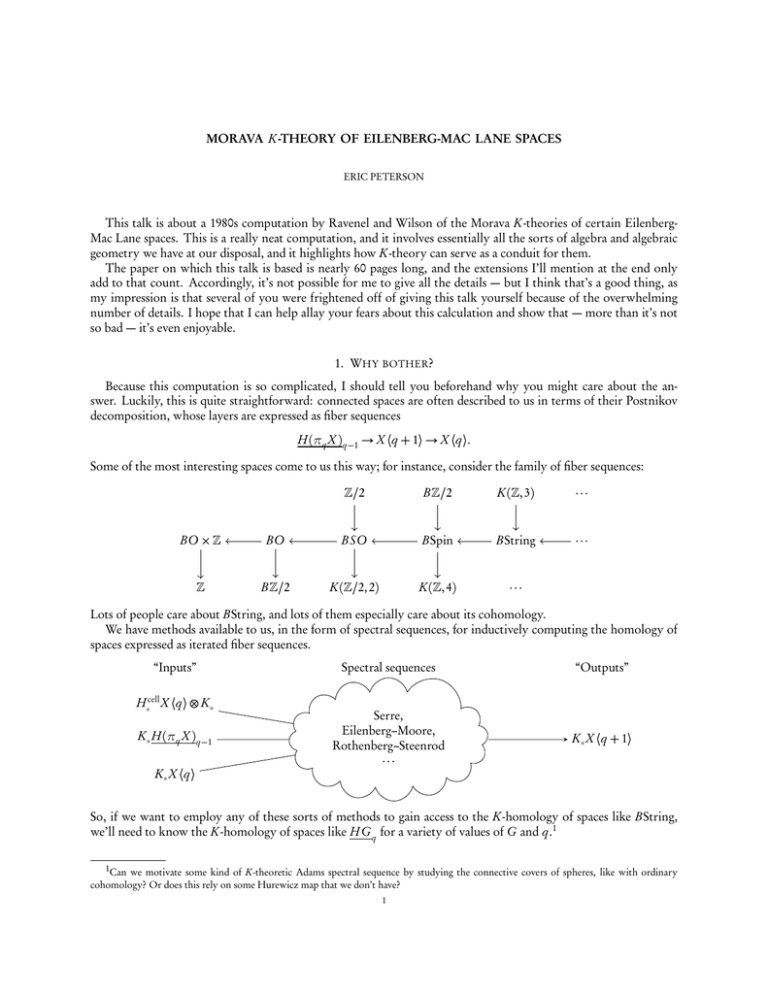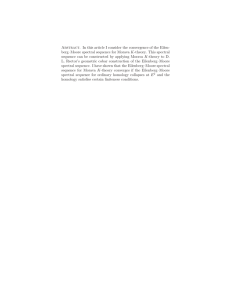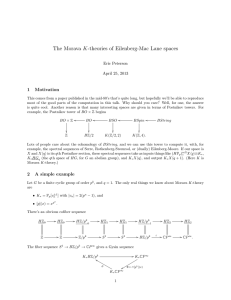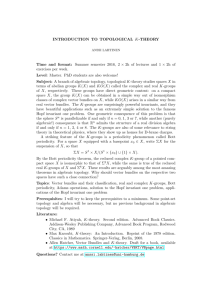MORAVA K-THEORY OF EILENBERG-MAC LANE SPACES
advertisement

MORAVA K-THEORY OF EILENBERG-MAC LANE SPACES ERIC PETERSON This talk is about a 1980s computation by Ravenel and Wilson of the Morava K-theories of certain EilenbergMac Lane spaces. This is a really neat computation, and it involves essentially all the sorts of algebra and algebraic geometry we have at our disposal, and it highlights how K-theory can serve as a conduit for them. The paper on which this talk is based is nearly 60 pages long, and the extensions I’ll mention at the end only add to that count. Accordingly, it’s not possible for me to give all the details — but I think that’s a good thing, as my impression is that several of you were frightened off of giving this talk yourself because of the overwhelming number of details. I hope that I can help allay your fears about this calculation and show that — more than it’s not so bad — it’s even enjoyable. 1. WHY BOTHER? Because this computation is so complicated, I should tell you beforehand why you might care about the answer. Luckily, this is quite straightforward: connected spaces are often described to us in terms of their Postnikov decomposition, whose layers are expressed as fiber sequences H (πq X )q−1 → X ⟨q + 1⟩ → X ⟨q⟩. Some of the most interesting spaces come to us this way; for instance, consider the family of fiber sequences: Z/2 BZ/2 K(Z, 3) ··· ··· BO × Z BO B SO BSpin BString Z BZ/2 K(Z/2, 2) K(Z, 4) ··· Lots of people care about BString, and lots of them especially care about its cohomology. We have methods available to us, in the form of spectral sequences, for inductively computing the homology of spaces expressed as iterated fiber sequences. “Inputs” H∗cell X ⟨q⟩ ⊗ K∗ K∗ H (πq X )q−1 K∗ X ⟨q⟩ Spectral sequences “Outputs” Serre, Eilenberg–Moore, Rothenberg–Steenrod ··· K∗ X ⟨q + 1⟩ So, if we want to employ any of these sorts of methods to gain access to the K-homology of spaces like BString, we’ll need to know the K-homology of spaces like H G q for a variety of values of G and q.1 1Can we motivate some kind of K-theoretic Adams spectral sequence by studying the connective covers of spheres, like with ordinary cohomology? Or does this rely on some Hurewicz map that we don’t have? 1 2. THE CASE OF H Z/ p j 1 Select an odd prime p ≥ 3 and a height n > 0, and write K = K(n, p) for the nth Morava K-theory at p. Since Morava K-theory factors through p-adic homotopy theory, it’s sufficient to think about the finite cyclic groups Z/ p j (and their colimit Z/ p ∞ , which we’ll come to). Before we get into anything complicated, I want to show you how you might expect a basic such computation to go, in case you haven’t seen much done with these K-theories before. The most basic situation is q = 1, so that we’re studying the classifying space H Z/ p j 1 = BZ/ p j . Keep in mind that really the only things we know about Morava K-theory are: (1) Its coefficient ring is K∗ = F p n [vn± ], which happens to be a graded field. [ p] (2) We also understand its “ p-series,” which is the action of the map CP∞ −→ CP∞ on cohomology. Namely, there is an isomorphism K ∗ CP∞ ∼ = K ∗ JxK for which we have the formula n [ p](x) = vn x p . In order to get anywhere, we’re going to have to make use of these facts and these facts alone. Start by recalling the short exact sequence pj Z− → Z → Z/ p j . pj This is a fiber sequence, and it in fact comes from delooping a fiber sequence of ring spectra H Z − → H Z → H Z/ p j . This in turn means that we can extend it to the right by using the going-around map: H Z0 Z pj H Z0 H Z/ p j 0 H Z1 Z Z/ p j S1 pj H Z1 H Z/ p j 1 H Z2 S1 BZ/ p j CP∞ [p j ] H Z2 ··· . CP∞ ··· . Any consecutive pair of arrows forms a fiber sequence. Several of these spaces have more familiar names, which is useful to know; I’ve added this information to the diagram in a second row. In the middle, one finds a circle bundle S 1 → BZ/ p j → CP∞ , and moreover this circle bundle arises from the following pullback diagram: S1 S1 BZ/ p j pt CP∞ [pj] CP∞ . Pulling back the Euler class for the universal bundle and writing out the induced Gysin sequence for homology, one produces the following exact couple: K∗ BZ/ p j i K∗ CP∞ − _ [ p j ](x) K∗−2 CP∞ . ∂ This cap product map is easy enough to analyze: the formula σ _ ω = σ 0 is defined to be dual to the map σ ∨ = jn ω ^ σ 0 , i.e., σ 0 is the answer to the question “what do I multiply by ω to get σ?” Since we know [ p j ](x) = ˙ xp , this question is easy to answer: writing β j for the class dual to x j , we have ( βi − p n j when i ≥ p n j , j βi _ [ p ](x) = ˙ 0 otherwise. In particular, this map is surjective — which means that i is its kernel, and ∂ is the zero map. So. . . now we know what K∗ H Z/ p j 1 is. Before we move on, I want to give an interpretation of this calculation — after all, this is a conference on chromatic homotopy theory, and we’ve now gone several minutes without any mention of algebraic geometry, which won’t do. This above exact couple dualizes to give an exact couple in cohomology: 2 K∗ BZ/ p j i K∗ CP∞ − ^ [ p j ](x) K∗−2 CP∞ , ∂ this time realizing K ∗ BZ/ p j as the quotient K ∗ CP∞ /[ p j ](x). Now recall that as far as algebraic geometry is concerned (as well as chromatic homotopy), the ring K ∗ CP∞ ∼ = K ∗ JxK is to be thought of as the ring of functions on a formal neighborhood of a smooth point of a 1-dimensional variety. Moreover, this formal variety comes with the structure of an abelian group object, and the element [ p j ](x) corresponds to the function which sends a point to its p j th iterate. In the quotient ring K ∗ JxK/[ p j ](x) we’ve enforced the identity [ p j ](x) = 0 — i.e., we are restricting to the vanishing locus of [ p j ](x), also known as the p j -torsion of the formal group. Writing “XK ” for the formal scheme associated to the K-cohomology of the space X , we summarize the above by writing j BZ/ pK = CP∞ [ p j ]. K This last line is really fantastic. You shouldn’t carry around all this nonsense about Gysin sequences and and cap products with you when you think about this fact. Instead, this last line tells you that K-theory takes an algebraic fact (Z/ p j is the p j -torsion of the circle group S 1 ) and produces from it the algebro-geometric analogue above. 3. POWER TOOLS So, now you know some of the flavor of this sort of computation. That we got an algebraically polite answer at the end is very common in this situation — one of the themes of Morava K-theory is that it is very good at preserving algebraic structure present on the source through to the target. This is what Ravenel and Wilson rely on to perform the computation for q > 1, and they begin by observing the following two pieces of structure: 3.1. Hopf rings. The first thing to notice is that our spaces H Z/ p j ∗ arise from not just a spectrum, but a ring spectrum. This gives us three collections of maps among them: (1) As they are spaces, they have diagonals ∆ : H Z/ p j q → H Z/ p j q × H Z/ p j q . (2) As they are deloopings of a spectrum, they have additions: ∗ : H Z/ p j q × H Z/ p j q → H Z/ p j q . (3) As they are deloopings of a ring spectrum, they have multiplications: ◦ : H Z/ p j q ×H Z/ p j q 0 → H Z/ p j q+q 0 . Because K∗ is a graded field, it comes with Künneth isomorphisms, and hence all this structure is carried over onto the algebraic output: the K∗ -modules K∗ H Z/ p j q are coalgebras, and they come with ∗-products and ◦-products. P Moreover, the ◦-product distributes over the ∗-product, in the sense that for ∆x = x 0 ⊗ x 00 , there is an equality X x ◦ (y ∗ z) = (x 0 ◦ y) ∗ (x 00 ◦ z). This at once, but it can be made somewhat manageable by giving it a name: altogether, the sum L∞ is a lot to swallow j K H Z/ p forms a ring object in the category of K∗ -coalgebras, also called a Hopf ring. q q=0 ∗ “This is overwhelming!” I can hear you say. Calm down. With so many operations it’s easy to produce an enormous number of elements out of combinations of just a few, giving us access to small presentations of exceedingly large objects — we’re actually getting out of doing work by noticing this. Additionally, there are very few such highly structured objects, and so knowing part of how a Hopf ring looks sometimes determines the rest of it for free. Both of these are too good to pass up. 3.2. Bar spectral sequence. The other tool we need is an inductive mechanism to move from H Z/ p j q to H Z/ p j q+1 . In the case of ordinary cohomology, Serre used the Leray-Serre spectral sequence to great effect to achieve this. This approach turns out to be intractable here, but there’s a nearby spectral sequence that works perfectly. Recall that because H Z/ p j is a connective spectrum, H Z/ p j q+1 can be written as a classifying space B H Z/ p j q+1 , which can be written as the realization |B H Z/ p j q | of a simplicial space. As a simplicial object, this comes with a filtration by skeleta, and the filtration quotients take the form F r /F r −1 ' Σ r (H Z/ p j q )∧r . Because Morava K-theory has Künneth isomorphisms, it carries these smash products to tensor products and so produces the bar complex in the category of algebras, i.e., K∗ H Z/ p j q 2 E∗,∗ = Tor∗,∗ (K∗ , K∗ ) =: H∗,∗ K∗ H Z/ p j q ⇒ K∗ H Z/ p j q+1 . 3 3.3. Interaction. Ravenel and Wilson don’t use these two tools in isolation: they interact wonderfully. The maps of spaces defining the ∗- and ◦-products can be defined inductively along with the iterated bar construction definition of H Z/ p j q . Namely, the ∗-product is essentially given by concatenating tuples in the above filtration, and the ◦product is given by acting on the (H Z/ p j q )∧r factor. Hence, these two maps respect the bar filtration, and so induce structure respected by the bar spectral sequence — in particular, there is the formula d (x ◦ y) = x ◦ d (y). Hence, knowledge of differentials in previous incarnations of this spectral sequence can be used to induce differentials in this one, provided we can appropriately decompose the classes we care about. 4. THE COMPUTATION OF H Z/ p j q , q > 1 So, our argument reduces to being able to accomplish the following two goals: (1) Analyze the behavior of the bar spectral sequence H∗,∗ K∗ H Z/ p j 0 ⇒ K∗ H Z/ p j 1 . (2) Produce a decomposition formula, so that we can use the base case to force the behavior everywhere else. 4.1. The base case. The base case is accomplishable precisely because we’ve already computed both the source and the target of this spectral sequence in the first part of this talk, and so the behavior of the differentials should be able to be determined by which pattern gives us the right answer. The first homology algebra is given by j j K∗ H Z/ p j 0 = K∗ [[1]]/⟨[1] p − 1⟩ = K∗ [[1] − [0]]/⟨[1] − [0]⟩ p . pj Then, the algebraic homology of the truncated polynomial algebra H∗,∗ K∗ [a∅ ]/a∅ is given by the formula pj H∗,∗ K∗ [a∅ ]/a∅ = Λ[σa∅ ] ⊗ Γ[φa∅ ], the combination of an exterior algebra and a divided power algebra. We know which classes are supposed to survive this spectral sequence, and hence we know where the differentials must be: d (φa∅ )[ p nj ] [i+ p n j ] ⇒ d (φa∅ ) = σa∅ , = σa∅ · (φa∅ )[i] . After this differential the spectral sequence collapses, but there are some multiplicative extensions to sort out when j > 1. Of course, these are all determined by already knowing the multiplicative structure on K(n)∗ H Z/ p j 1 . 4.2. The inductive step. The inductive step turns out to be extremely index-rich, so I won’t be so explicit or [ pi ] complete, but I’ll point out the major landmarks. It will be useful to use the shorthand a(i) = a∅ , where (i ) is thought of as a multi-index with one entry. (1) Our inductive assumption is K∗ H Z/ p j q = Altq H Z/ p j 1 , under the ◦-product. (2) Computing the algebraic homology of K∗ H Z/ p j q yields a tensor of divided power and exterior classes, a pair for each algebra generator of K∗ H Z/ p j q . (3) There is a wonderful rewriting formula: (φa(i1 ,...,iq ) )[ p ] ≡ (φa(i1 ,...,iq−1 ) )[ p ] ◦ a(iq + j ) mod ∗ -decomposables. j j (4) Since every class can be so decomposed, all the differentials and extensions are determined by the previous spectral sequence. In particular, classes are hit by differentials exactly when iq + j is large enough. (5) The inductive assumption that K∗ H Z/ p j q+1 is an exterior algebra holds, and the class (φa(i1 ,...,iq ) )[ p ] represents a( j ,i1 + j ,...,iq + j ) . j 4 5. CONSEQUENCES So, that’s the content of the original Ravenel-Wilson manuscript. They go on to use this to deduce something about B P Conner-Floyd-Chern classes, but I’m not super interested in that, so I’m inclined to skip it. There are lots of enlightening small extensions of the above result, though, and I want to talk about some of those. Before we do that, we can also immediately deduce something about our question from earlier: because our answer is given in terms of exterior powers of a finite-dimensional vector space, the Morava K-theory of Eilenberg-Mac Lane spaces is eventually trivial, and the co/homology of Postnikov towers must therefore eventually stabilize. 5.1. The p-divisible group. Charmaine and Arnav have already told us what a p-divisible group is, and Nat’s about to remind us later today, so I’m not going to — for now and for us, a p-divisible group is exactly a group scheme arising from Spf K ∗ H Z/ p ∞ q . Keeping track of the coalgebra structure through our homology computation describes the ring structure on K ∗ H Z/ p ∞ q : it is a formal power series ring whose indecomposables are spanned by the classes dual to a(1,...) . In algebro-geometric notation, one writes n−1 (H Z/ p ∞ q )K ∼ = Â(q−1) . Using the ∗-product, this means that K ∗ K(Z/ p ∞ , q) always begets a formal group (i.e., a group scheme isomorphic to  m for some m), and in the cases of q = 1 and q = n, it even yields a 1-dimensional formal group. The case q = 1 is exactly the case of CP∞ , with which we’re well-familiar, but the other case q = n is new and strange. It can be shown that: the formal group (H Z/ p ∞ n )K has height 1; that for n odd it is isomorphic to Ĝ m ; and that for n even it becomes isomorphic to Ĝ m after extending the ground field by the primitive root of unity ζ2 p−2 . Facts about these objects are best-organized by a tool called “Dieudonné theory,” which is an analogue of a theory of Lie algebras for p-divisible groups, but I can’t go into that now. 5.2. Deformations and E-theory. In addition to telling you what a p-divisible group is, Nat’s further going to tell you how interesting they can become in the context of Morava E-theory, so it would do well for me to tell you about the E-theories of these spaces. Morava’s E- and K-theories are supposed to be tightly intertwined on spaces for which they’re even-concentrated, so morally we should be able to use our answer for K-theory to produce one for E-theory. This turns out to be accomplishable, and the answer you get for E-theory is identical to that for K-theory, replacing the letter K with E everywhere: j (Hopkins-Kuhn-Ravenel) BZ/ p ∼ = CP∞ [ p j ], E E q E∗∨ H Z/ p j q ∼ = Alt E∗∨ H Z/ p j 1 . (P.) 5.3. For the interested reader. I strongly recommend that the person who wants to learn how to do these computations work through (H F p )∗ H F p q using the exact same set-up, even beginning with the simpler case of p = 2. This is far easier than the Ravenel–Wilson calculation, involves essentially no indices, and gives an extremely cute description of the unstable dual Steenrod algebra: (H F2 )∗ H F2 q = Altq (H F2 )∗ RP∞ . 5






